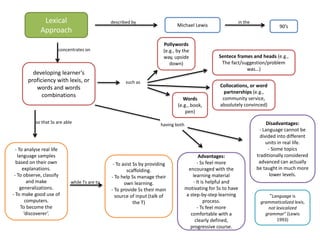Report
Share

More Related Content
What's hot
What's hot (20)
A brief history of language teaching, the grammar translation method

A brief history of language teaching, the grammar translation method
TEFL - The Oral Approach & Situational Language Teaching

TEFL - The Oral Approach & Situational Language Teaching
Observing learning and teaching in the second language classroom

Observing learning and teaching in the second language classroom
Similar to Lexical approach c-map
Similar to Lexical approach c-map (20)
UTPL-METHODOLOGY AND DIDACTIS I-II-BIMESTRE-(OCTUBRE 2011-FEBRERO 2012)

UTPL-METHODOLOGY AND DIDACTIS I-II-BIMESTRE-(OCTUBRE 2011-FEBRERO 2012)
Your beliefs about Language,Learning & Teaching.ppt

Your beliefs about Language,Learning & Teaching.ppt
International House JOURNAL OF EDUCATION AND DEVELOPMENT SPRING 2010

International House JOURNAL OF EDUCATION AND DEVELOPMENT SPRING 2010
Methodology information, about university students

Methodology information, about university students
More from Camila__
More from Camila__ (20)
Lexical approach c-map
- 1. Lexical Approach Michael Lewis 90’s developing learner’s proficiency with lexis, or words and words combinations Words (e.g., book, pen) Pollywords (e.g., by the way, upside down) Collocations, or word partnerships (e.g., community service, absolutely convinced) Sentece frames and heads (e.g., The fact/suggestion/problem was…) - To asist Ss by providing scaffolding. - To help Ss manage their own learning. - To provide Ss their main source of input (talk of the T) - To analyse real life language samples based on their own explanations. - To observe, classify and make generalizations. - To make good use of computers. To become the ‘discoverer’. Advantages: - Ss feel more encouraged with the learning material - It is helpful and motivating for Ss to have a step-by-step learning process. - Ts feel more comfortable with a clearly defined, progressive course. Disadvantages: - Language cannot be divided into different units in real life. - Some topics traditionally considered advanced can actually be taught in much more lower levels. concentrates on described by in the such as so that Ss are able while Ts are to having both "Language is grammaticalized lexis, not lexicalized grammar" (Lewis 1993)
